If you’ve been tirelessly searching for the best ways “how to potty train your Labrador puppy,” your quest ends here. Welcoming a Labrador puppy into your home is an adventure filled with joy and challenges, one of the most daunting being potty training.
It’s a common pain point for many Labrador owners, often leading to frustration, messes, and a sense of helplessness. But fear not!
As an expert in canine behavior and training, I understand the intricacies of puppy potty training and the unique needs of Labrador puppies.
This article is tailored specifically for you, the dedicated Labrador owner, who seeks not just any training method but a compassionate, effective approach to guide your furry friend.
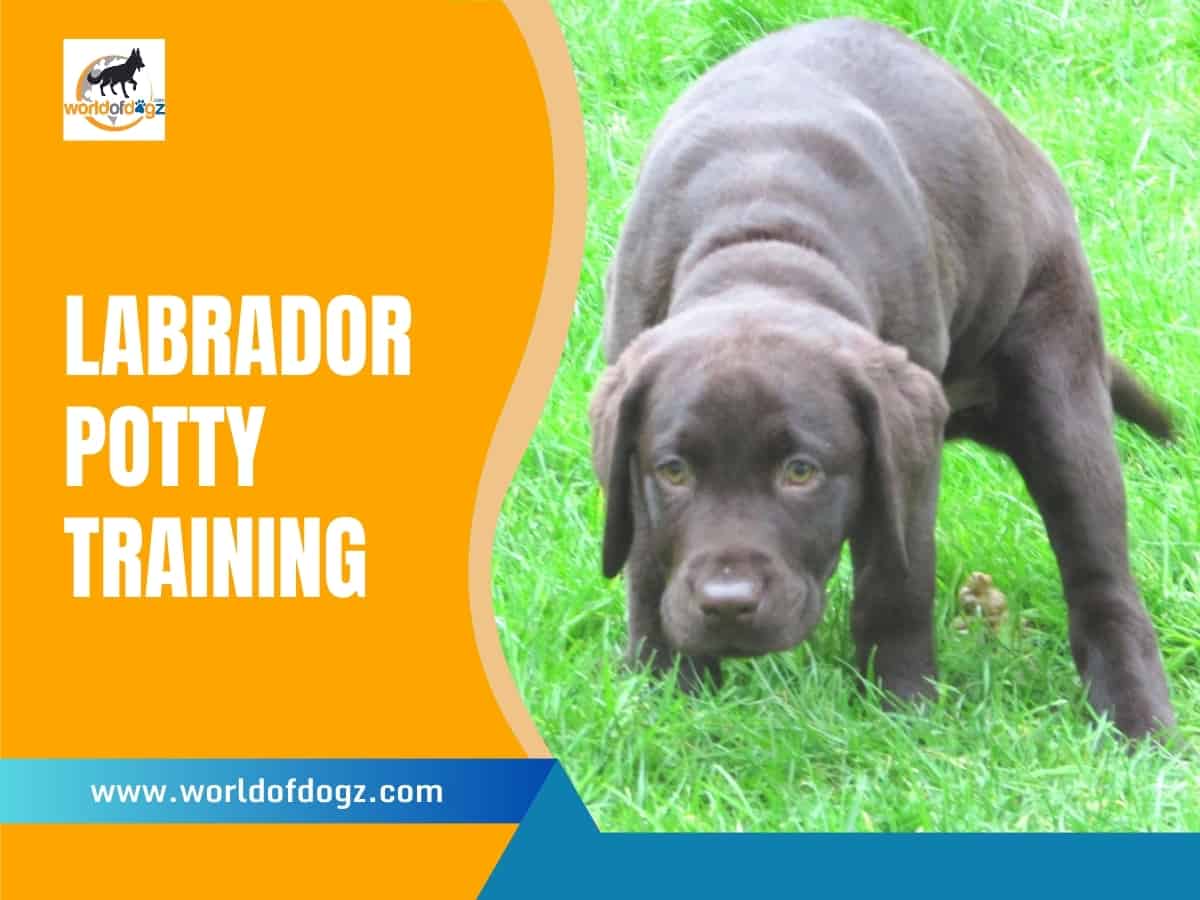
When are Labrador Puppies Potty Trained?
Although puppies soon learn where they should go to potty, they can’t fully control their bladder. So, you may wonder how long the whole process takes.
Labrador puppies are typically fully potty trained between 4 and 6 months of age. Most are usually entirely house-trained by six months, but some may still have the occasional accident up to a year old.
Some pups will learn quicker than others, especially if they are easily excitable! Never punish your Lab puppy for having the odd toilet accident, as this is normal.
Let’s look at the factors that can influence the length of time it takes to successfully toilet train your Lab:
- History. Labrador puppies from a shelter or those living in poor conditions (e.g., an unethical breeder) might need a little longer to master toilet training. They must break bad habits before learning new, desirable ones. For example, you shouldn’t use a crate if they’ve been left to mess in their crate.
- Size of the puppy. Size can be a factor in determining when your Lab will be potty trained. Smaller dogs are more difficult to toilet-train. So, if you have the runt of the litter, he may take a while longer.
But why is this? Some clinicians have suggested that smaller dogs have a higher metabolism and a smaller bladder, causing them to pee more frequently, leading to inadequate potty training. This theory hasn’t been proven, but this study of 735 dogs demonstrated that smaller breed dogs take longer to potty train than large breeds.
- Technique. Many mistakes are made by pet parents who wrongly believe in some methods. Yelling, physical punishment, or rubbing your dog’s nose in his pee or poop after an accident will not work and will only cause your puppy to fear and distrust you. Here’s the right way to discipline a Labrador, including what NOT to do. I’ll cover the correct technique further in the article.
- Situation. Your circumstances and where you live may influence when your Lab is entirely potty trained. For instance, living in a high-rise apartment may take longer, as getting your puppy outside takes a while. In this situation, using puppy pads or sheets of newspaper is advised.
- Medical issues. Some medical problems could extend your Lab’s potty training time. If your pup cannot master peeing in the house, he might have a urinary tract infection. If he’s pooping, he may have intestinal parasites, such as worms.
If you have any doubt, take your pup to the vet to rule out anything medical. If your Lab suffers from anxiety, he may not like his crate. This can prolong potty training time.
Check Out This Video for Some Other Medical Reasons to be Aware of…
When to Start Puppy Potty Training
When you first bring your new Labrador pup home, there are many things to do. From sorting a routine, introducing him to his crate, starting basic obedience training, visiting the vet for a first check-up, microchipping, etc. So, when do you start potty training?
Start potty training your Lab puppy the first day you bring him home. Puppies usually leave their mother at eight weeks old, but you should start on day one, no matter their age.
Start by showing your Lab where you want him to potty, such as a sectioned-off area of your yard or garden. Make the area you want your Lab to do his business look different from the rest of your yard or garden so he’ll learn to recognize it.
A good idea is to fence off an area and add something like bark chippings. Most dogs prefer to potty on natural surfaces instead of paving or concrete.
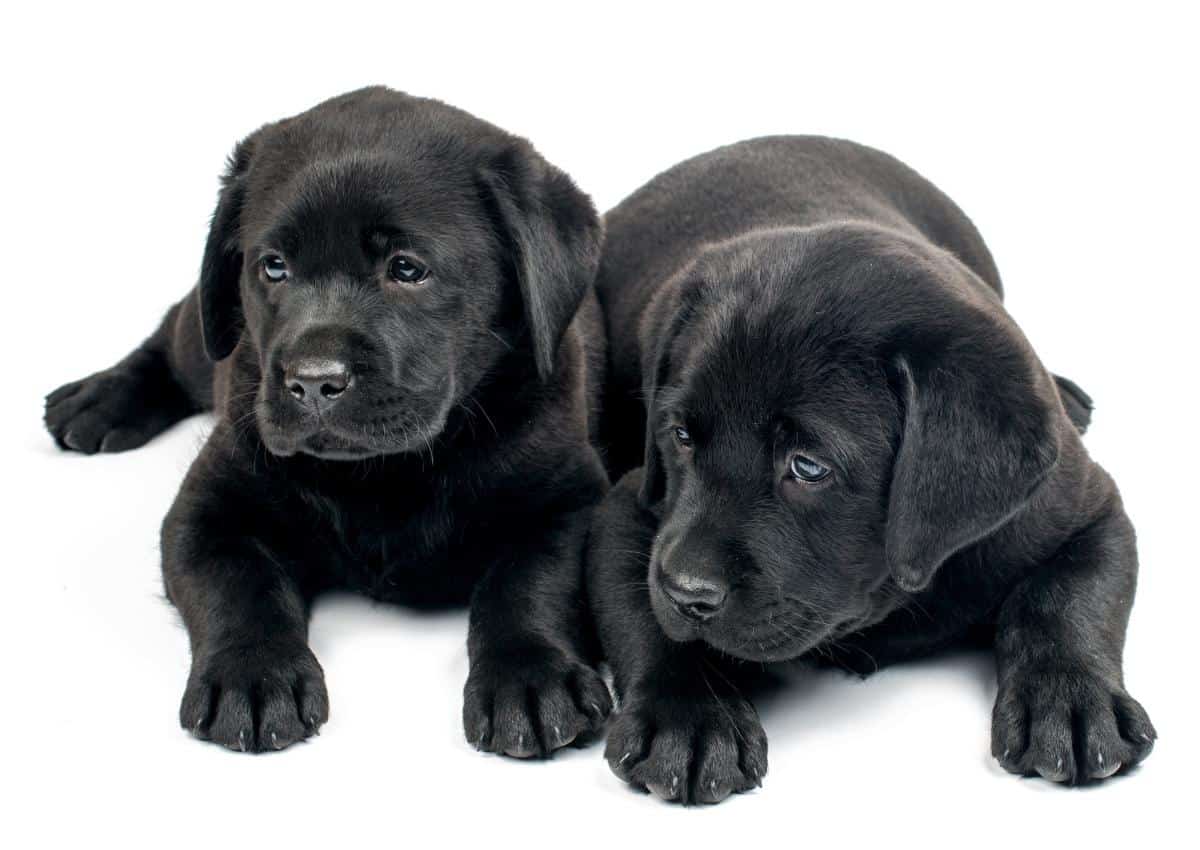
I remember arriving home with my new pup as if it were yesterday. I took her to a small sectioned-off part of the lawn where I wanted her to go, and she soon got the hang of it.
Related: Lab Puppy Training Schedule: What to Teach Month by Month
Negating House-Training Challenges
Labs are smart and are ranked 7th of all dog breeds for intelligence, according to renowned canine psychologist Stanley Cohen in his book, The Intelligence of Dogs. But how do they fare when it comes to potty training?
Lab puppies are not hard to potty train as they are intelligent, highly social, and love to please. They also love both physical and mental stimulation.
As one of the brightest dog breeds, they will find house training easy if you establish a schedule with consistent training principles.
Their sound, friendly temperament and learning ability make them ideal working dogs. They are often preferred for guide dogs, therapy, and search and rescue.
If you are having trouble completing potty training with your Lab, read on to find out what to do! But first, we must look at how long puppies can realistically hold their bladder.
How Long Can a Lab Puppy Go Without Peeing?
You should regularly take your Labrador outside to pee when you begin potty training. This is one of your main tasks! If you’re wondering how often you should do this, we must first look at how long a Lab pup can go without peeing.
A Lab puppy can usually go without peeing for one hour every month of age. So, an 8-week-old pup won’t be able to hold its bladder for more than two hours.
However, allow young puppies to potty more frequently to avoid accidents. It’s recommended to take them out hourly at first.
I think it’s far better to be safe and take your dog out more regularly. That way, you’ll have fewer accidents to clean up, and your pup will quickly learn where and when you want him to go.
Here’s a handy table showing the puppy’s age and the approximate frequency of toilet breaks required.
| Age of Lab Puppy | Frequency of Potty Breaks |
|---|---|
| 2 months | Every hour |
| 3 months | 1-2 hours |
| 4 months | 2-3 hours |
| 5 months | 3-4 hours |
| 6 months | 4-5 hours |
Your Labrador must also be taken outside shortly after eating and drinking. Also, allow him to eliminate after physical activity and when he wakes after a nap.
The question of how long Labradors can hold their bladder complements the question of how long you can leave your dog alone. Check out my guilt-free guide to learn: How Long Can Labradors Be Left Alone?
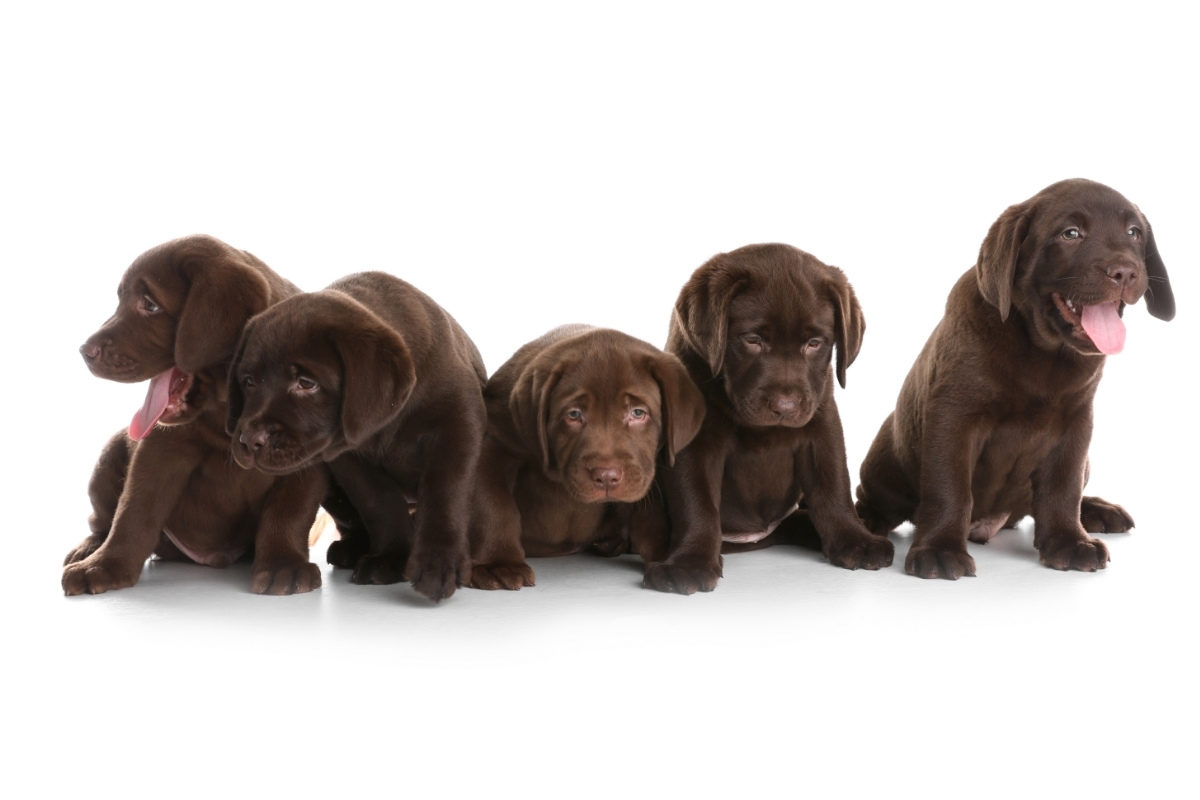
How To Potty Train a Labrador Puppy
The principles of Lab potty training are the same whether you choose to use a crate or not. However, a crate is recommended when you can’t fully supervise your pup. So, how do you potty train a Lab puppy?
To potty train a Labrador puppy – follow these basic steps.
- Control your Lab’s environment
- Create a separate area
- Introduce the crate
- Allow frequent potty breaks
- Create a schedule
- Learn to spot the signs
- Never punish your Lab after an accident
- Use potty pads as a temporary indoor alternative
- Recognize excitement urination
- Be aware of submissive urination
- Allow more freedom as your puppy improves
The ultimate aim of housebreaking your puppy is to prevent accidents. Here’s how to potty train a Lab puppy – fast:
1. Control His Environment
When potty training your puppy, the first thing to do is to control his environment. By this, I mean managing where your Lab can and can’t go, as he should be constantly supervised.
Use a long leash and attach your pup to your waist, even inside the house. This allows you to look out for warning signs.
2. Create a Separate Area
Your Labrador needs his own “room” or “puppy zone.” A great way to set this up is to use a crate and exercise pen combination where the playpen is complementary to the crate. Your pup will sleep in the crate, whereas the playpen provides extra space.
Make sure to choose a pen with a door so you can attach it to the crate, such as the Midwest Homes for Pets Folding Exercise Pen from Amazon.
- Secure double latch step-through door access, Exercise Pen / Pet Playpen folds flat for convenient storage.
- Each panel measures 24W x 42H, Exercise Pen / Pet Playpen provides 16 square feet of enclosed area (1.5 meters)
- Includes 4 ground anchors for outdoor use and 4 thumb-snaps for easy assembly; Easliy attaches to your crate for a playspace area
- Easy set-up & no tools required for assembly. Exercise Pen includes 1 year manufacturers warranty; Not Recommended for Puppies or Dogs That Jump
- Celebrating over 100 years as a small, family-owned business that supports over 150 employees in the U
Prices pulled from the Amazon Product Advertising API on:
Product prices and availability are accurate as of the date/time indicated and are subject to change. Any price and availability information displayed on [relevant Amazon Site(s), as applicable] at the time of purchase will apply to the purchase of this product.
Note: Clicking the above link(s) will take you to Amazon or an online store where we have an affiliate relationship. If you make a purchase, we may earn a commission at no additional cost to you.
I also recommend the Midwest Homes for Pets icrate. It’s a perfect fit to complement the playpen and comes with everything you need, including a divider panel and wipe-clean tray.
- Newly enhanced with added security features to keep your pet safe | Slide-bolt door latches now feature patented Paw Block and locking tips to create a safer, more secure home for your pet
- iCrate double door dog crate measures 42L x 28W x 31H inches and is suitable for large dog breeds with an adult weight of 70-90 pounds. If your dog’s weight or measurements are on the higher side for this crate, we recommend buying the next crate size up
- Dog crate includes a divider panel, durable & leak-proof plastic pan, protective rubber feet, carrying handle, and customer support team based in Indiana
- Easy to assemble & portable | Dog crate sets up in seconds with no tools required and conveniently folds flat for travel
- Durable & strong, quality construction creates a secure place for your dog to fulfill their natural instinct to den. Proper ventilation, large door openings with low thresholds, and rounded corner clips make iCrate a safer crate experience for your dog. Perfect for housetraining
- PLEASE NOTE: MidWest Homes for Pets manufactures the iCrate & Life Stages dog crates. Assembly and safety instructions are included; please read all safety instructions prior to use
- Pet Weight Max: 40 lbs lb(s). Pet Weight Min: 26 lbs lb(s).Breed Size: Med
Prices pulled from the Amazon Product Advertising API on:
Product prices and availability are accurate as of the date/time indicated and are subject to change. Any price and availability information displayed on [relevant Amazon Site(s), as applicable] at the time of purchase will apply to the purchase of this product.
3. Introduce the Crate
Slowly introduce the crate when crate training your Lab over the first few days. Don’t force him to go inside, but let him naturally explore it by throwing a tasty treat inside.
If you get your Lab to love his crate by creating positive associations, house training will go nice and smoothly as he won’t mess up where he sleeps.
When you let your pup out of his crate, immediately take him outside. Supervise him closely when he is away from his room by keeping him attached to you on a long leash.
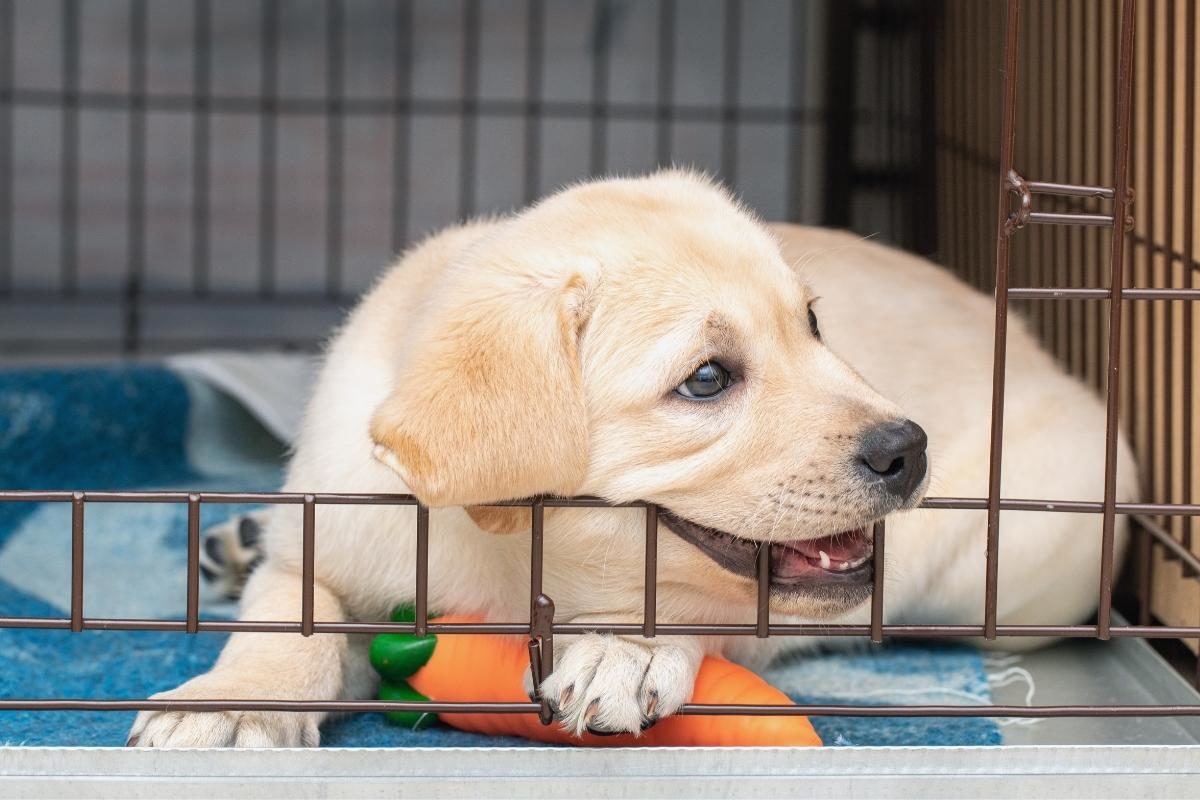
4. Allow Frequent Potty Breaks
Give your dog lots of opportunities to go outside. It’s better to take him outside more frequently than what’s really necessary rather than not taking him out often enough.
5. Create a Puppy Potty Schedule
Dogs thrive off routines, including mealtimes, exercise, and potty training! You can set an alarm on your watch or phone to remind you to take your dog outside to his toilet area.
Your pup must go first thing in the morning, after a meal or drinking, when he wakes from a nap, after playtimes, and before bedtime.
6. Learn To Spot The Signs
Get to know your Lab’s body language and learn to spot the signs when he needs to go and eliminate. Look for clues such as sniffing the floor or carpet, circling, restlessness, becoming overexcited, whining, or turning towards the door.
7. Never Punish Your Lab After an Accident
Just as you wouldn’t punish a baby, never punish your dog if he has an accident. This includes whether you catch him in the act or if it happened a while ago. Your dog will have no idea what he is being punished for!
This is because dogs have terrible short-term memory and forget an event in two minutes. Instead, take him straight outside and reward him with a treat and lots of praise if he finishes off his business.
8. Use Potty Pads as a Temporary Indoor Alternative
Potty pads can be handy in extended periods of bad weather or if you live in a high-rise apartment and it takes longer to get outside. They can also be useful when traveling.
Start by covering your dog’s area with the pads. Gradually reduce the covered floor over the next few days, as your pup will instinctively learn to pee where he’s been before.
9. Recognize Excitement Urination
Don’t mistake excitement pee as a potty accident. This is when your Labrador gets so excited he will pee a small amount. It may happen when a family member or friend visits.
To prevent this, allow your dog to eliminate before a visitor arrives and ensure visitors make their entrance low-key with no fuss, even ignoring the pup for a few minutes.
Dogs will usually grow out of excitement pee by 18 months of age.
10. Be Aware of Submissive Urination
This is also common, but your puppy will outgrow it. It occurs when your Labrador wants to show submissive status to a person or another animal. He may squat and urinate during specific situations.
To prevent it, avoid yelling and physical punishment, appear less intimidating when approaching, kneel, and stroke under his chin instead of the top of his head.
11. Allow More Freedom as Your Pup Improves
Gradually increase the size of your Lab’s room as the weeks pass, and his potty training progresses.
At first, keep his sleeping area small and then gradually increase the size slowly and methodically. Remove the divider in the crate or make the playpen area larger if you aren’t using a crate.
You may need to experiment with this, but don’t delay taking a step back if your Lab relapses.
Learn More on How to Potty Train Your Puppy Here…
Using a Crate to Potty Train
A faster way to train your Lab puppy is to use a crate, making it easier. You can use a crate to your advantage as it helps your pup develop bowel and bladder control quickly.
To potty train a Lab puppy with a crate, use the crate as a tool. Dogs naturally want to keep their sleeping area clean and won’t want to mess in their crate.
When the door is closed, your Lab will let you know he needs to eliminate by whining or scratching. He will learn self-control quickly.
When your puppy tells you he needs to go outside, don’t delay and get him to his designated toilet area. Crates are great when you cannot fully supervise your puppy and are an ideal way to control his environment.
However, you still need to keep a close eye on him and spot the signs when he needs to go.
If your dog has accidents overnight in his crate, it’s probably too big. Make it smaller using a divider. He will be less likely to poop in a smaller sleeping area.
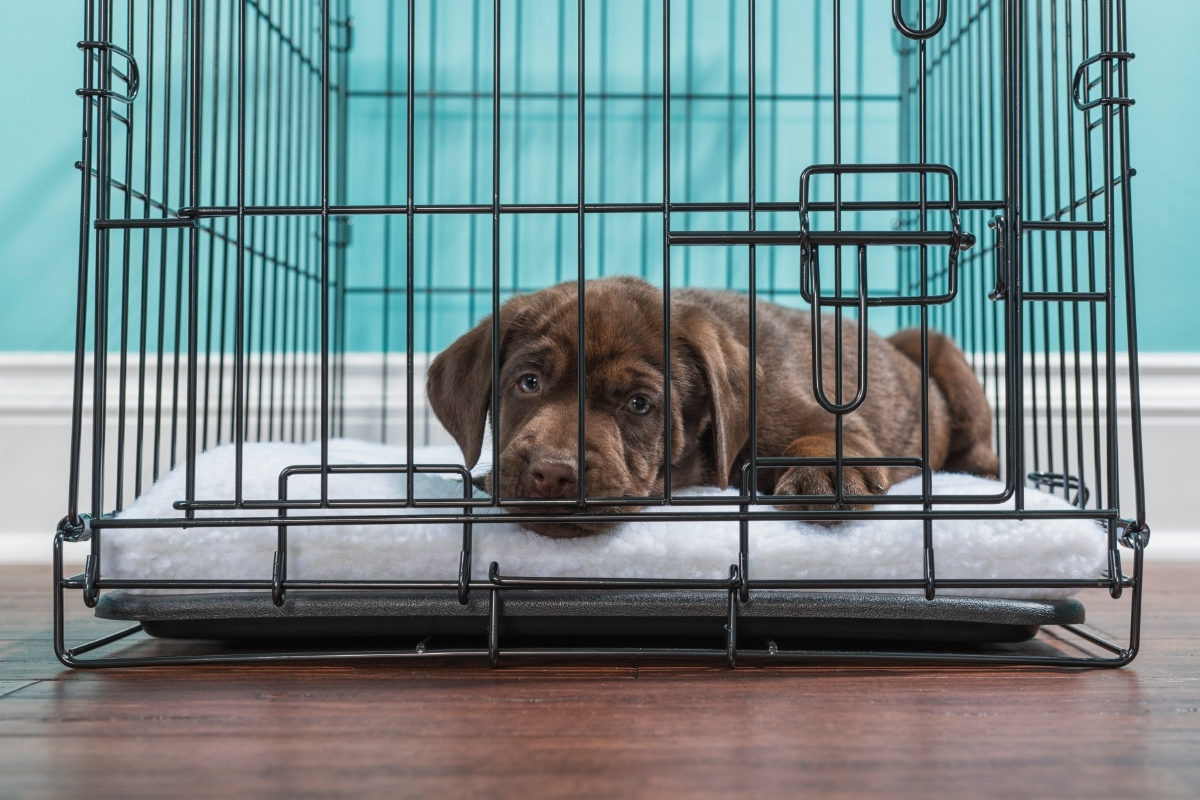
PRO TIP! Check out my recommendations for the Best Dog Crates for Labradors (and Playpens), including soft crates, travel crates, and furniture styles.
Non-Crate Strategies
If you don’t like the idea of crate training, don’t worry, as you can still successfully house-train your dog. Just be aware that it will probably take a little longer.
To potty train your Labrador puppy without a crate, control his environment by creating a “puppy zone” using dog gates, a playpen, or dog gates to section off an area of the house.
When away from his confinement, tether your pup to you with a long leash and establish a strict potty break schedule.
If you choose dog gates, there are many styles you can choose to match your decor and configure how you like. Check out the Carlton Extra Tall Gate, which is perfect for your Labrador.
Keep your puppy in his “puppy zone” when you can’t directly supervise him. This area should contain training pads or newspapers.
Mastering Potty Training for Pups Aged 3-6 Months
Most puppies are around eight weeks old when they leave their mother and littermates, but occasionally, your pup may be a little older when you first bring him home.
You may wonder how to potty train an older puppy and whether you should do anything different.
Generally speaking, you should follow the same principles as training an 8-week-old Lab. However, a more mature puppy should be able to grasp housebreaking quickly. As your pup’s tiny bladder develops, he should also be able to control it better.
Here’s a table showing the benefits of potty training older puppies between 3-6 months of age:
| Age of Puppy | Benefits |
|---|---|
| How to potty train a 3-month-old Lab | Will learn his designated toilet area quicker. Potty breaks should be every 1-2 hours. |
| How to potty train a 4-month-old Lab | You can extend his area sooner. Potty breaks should be every 3-4 hours. |
| How to potty train a 5-month-old Lab | You can extend his own area sooner. Potty breaks should be every 3-4 hours. |
| How to potty train a 6-month-old Lab | You can allow longer between breaks. Potty breaks should be every 4-5 hours. |
Essential Tips for Potty Training Success
Below are the best potty training tips for your Lab puppy. Follow these for complete success:
- Be consistent in your training.
- Start on the first day you bring your pup home.
- Show your pup the area outside where you want him to go.
- Introduce him to his sleeping area, whether a crate or bed.
- Use verbal cues such as “go potty” or “pee-pees.” It doesn’t matter what you say if you use the same command.
- Use rewards-based training and give lots of praise with an enthusiastic “yes!”
- Create a schedule and stick to it!
- Don’t fuss with your pup in the morning. Get him straight outside.
- Use the same route when leading your dog to his designated toilet area.
- Be persistent and patient.
- Accept that accidents will happen. If you catch your dog during an accident, pick him up and take him outside to his designated toilet area.
- Focus your efforts on preventing future accidents.
- Don’t rush your Lab’s potty break. Give him time to sniff around and explore.
- Take some time off work for the first few days as you will be busy!
Do Lab Puppies Need to Go Potty During the Night?
When I first picked my puppy from the breeder, I distinctly remember asking if I should wake her to pee at night.
Lab puppies don’t need to go potty during the night as they usually can hold their bladder longer when they are asleep.
The time they can last will vary, but generally, 8-week-old puppies can last 6-7 hours, mainly if their water intake is limited before bedtime.
Nonetheless, it’s a good idea to allow your dog to sleep near you for the first couple of weeks, and if he does stir or whimper during the night, you can carry him outside and allow him to pee.
Related: Should You Let Your Labrador Puppy Sleep With You?
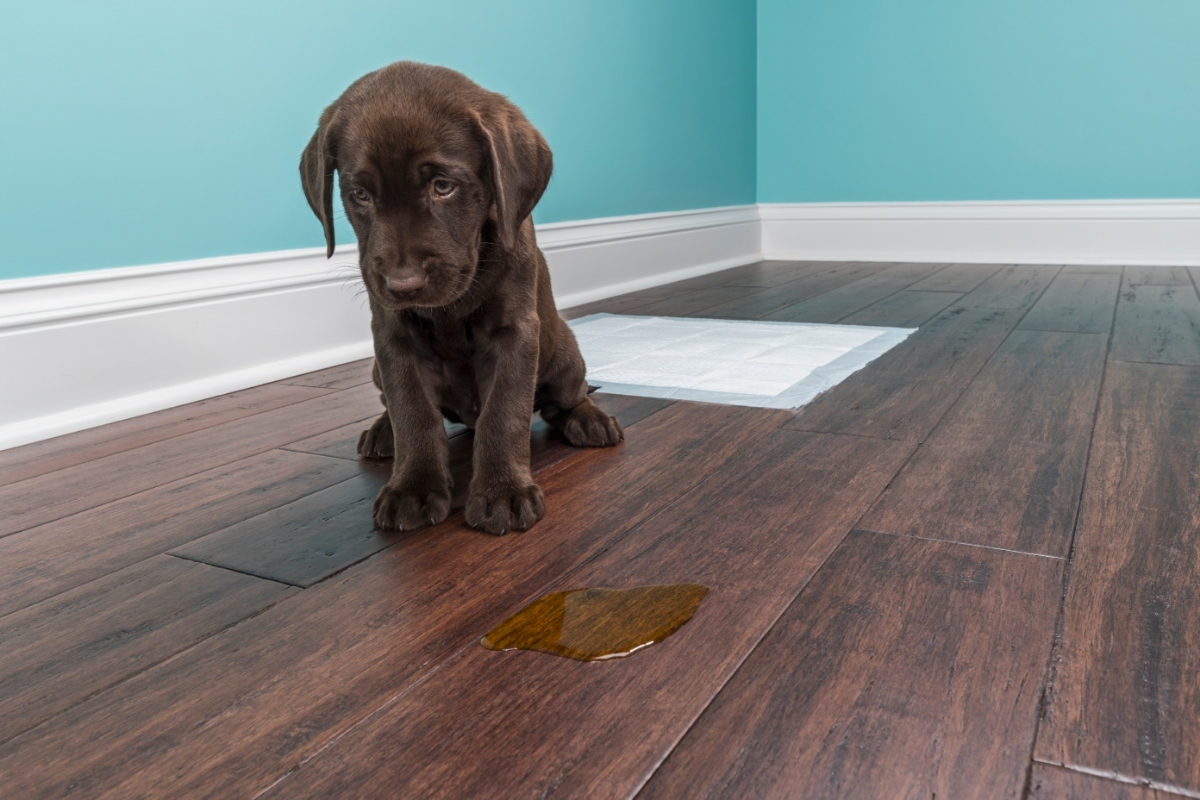
Common Puppy House Training Mistakes
Many new pet parents wrongly assume puppies can be potty trained in a week! Don’t get drawn into misleading headlines. People also make many mistakes when potty training their Labrador.
Let’s look at the main ones:
- Unrealistic expectations. Don’t expect your dog to be fully trained in a week or two. House training can take a few weeks to months.
- Failing to control his environment. Don’t let your Labrador have free reign of the house. Use a crate playpen combination or dog gates to make a safe “puppy zone.”
- Failing to supervise your puppy. It’s essential at all times. Don’t get lazy!
- Expecting your Lab to tell you when he needs to go out. This is unrealistic, so make sure you take him out at regular intervals.
- Leaving too long between toilet breaks. Even in poor weather, your pup still needs to go outside!
- Using a crate that’s too big. Although it’s wise to buy a larger crate to allow your dog to grow into, use a divider at first.
- Leaving your Lab too long in his crate. There are many misconceptions on this topic. Here’s my article on how long you can leave a Lab in a crate for genuine insight.
- Failing to recognize signs. Look for signs and your pup’s body language that he needs to eliminate.
- Overfeeding. Don’t overfeed your dog, and stick to a feeding schedule.
- Wrongly punishing the dog. Don’t yell at your pup when he has an accident. Another big mistake is physical punishment or rubbing his nose in his mess!
- Leaving the back door always open. Although this allows your pup to go when he pleases, it doesn’t teach him to learn self-control.
- Failing to stay with your Lab outside. If you don’t remain with your pup, he might not pee. You won’t know if he’s been, and you aren’t able to reward him once he’s done his business!
- Not waiting long enough outside. Allow 5-10 mins, let him have a good sniff, and allow him to wander around. Avoid distractions, such as children playing or other pets.
- Not removing his poop from his designated toilet area. If you don’t clean up your dog’s mess, he might be reluctant to poop there next time!
- Not keeping him off carpeted areas. Dogs prefer to eliminate on nice soft carpeted areas instead of hard floors. Keep your pup away from carpeted areas as much as possible, as urine smell is harder to remove.
- Failing to clean up accidents correctly. If your dog can still smell traces of urine, he will be attracted to the same spot to pee again! Clean up thoroughly using an enzymatic cleaner. These remove odors and eliminate stains. Don’t use ammonia products like bleach, as they smell like urine.
- Letting your guard down. Don’t let your guard down! This is common around the 3-week mark, especially if you’ve been having a lot of success. It can be a mistake, so stay consistent, or you’ll undo all your good work!
- Fear of regression. Don’t hesitate to take a step backward following a spate of accidents. For example, reduce your Lab’s living space again.
- Failing to recognize a medical issue. A urinary tract infection or another medical issue could be the problem of a spate of accidents.
Final Thoughts
New puppy owners often ask me, “How do you know when your puppy is potty trained?”
Puppy house training is typically complete when your Labrador has almost no potty accidents for a couple of months, AND he can go several hours between breaks.
You will achieve this far quicker if you stick to a schedule, control your dog’s environment, and recognize the signs when he needs to go. Remember to give lots of praise and remain patient.
If you consistently do all these things, your Lab puppy will be potty trained quickly.
If you find toilet training your puppy really difficult, or if you notice he’s having increased accidents, there may be a medical reason. Your vet is the perfect professional to help you with this.







